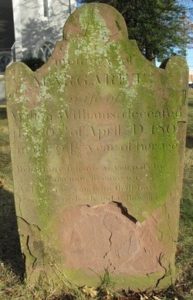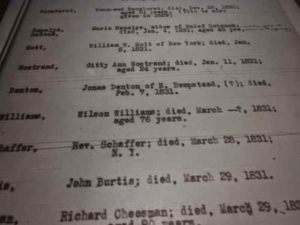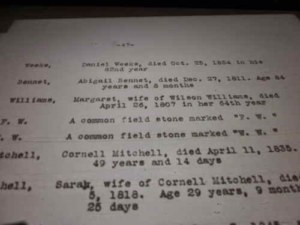Originally published on genealogyatheart.blogspot.com 23 Apr 2015
 Sometimes in genealogy we get so consumed with the names, places, and dates of our ancestors that we overlook the details that tell us much about their character.
Sometimes in genealogy we get so consumed with the names, places, and dates of our ancestors that we overlook the details that tell us much about their character.
The cemetery records transcribed by Josephine Frost from an earlier book by Henry Onderdonk broke through a 16 year genealogical brick wall and gave insight on the spiritual beliefs of the Wilson Williams Family:
“Williams, Wilson Williams: died March –?, 1831; aged 76 years.”
“Williams, Margaret. Wife of Wilson Williams, died April 26, 1807 in her 64th year
F.W. A common field stone marked “F.W.”
W.W. A common field stone marked “W.W.”1
The obvious information provided by these records are the name of the deceased, month and year of death, age at death and type of grave marker. For Margaret, her spouse’s name is also provided. F.W. most likely is a mistranscription of Wilson’s father, Thomas Williams.
There is much more information provided that isn’t initially obvious, however. The first hint is the mention of a common field stone. Onderdonk and DeHart (1884) tell us that the Dutch Reformed denomination custom “In early times farmers often interred their dead on their farms and put up at their graves a rough flat stone with the initial of the name, and year of decease rudely cut thereon.”2 From the record we know that Wilson and F.W. are following the Dutch Reformed tradition of burial.
But what about wife Margaret? There is no mention of a common field stone marker for her.
To locate picture of the markers, death dates were inputted into Find-a-Grave. No record for F.W, W.W., Thomas or Wilson Williams was found. The common field stone markers may be missing or may have been missed by the volunteers who photographed the cemetery. There is a record for Margaret Williams; she is noted to be buried in Christ Church Cemetery, Manhasset, Nassau, New York3. :
 We know this is our Margaret because the death date, spouse’s name and her name match the church burial record of Frost’s transcription.
We know this is our Margaret because the death date, spouse’s name and her name match the church burial record of Frost’s transcription.
Margaret’s headstone reveals that she did not follow the field stone custom as did her husband. Margaret also did not follow what Walter (1987) notes is “the traditional Dutch practice of the wife retaining her maiden name” on her marker.4
A more careful examination of Margaret’s tombstone will give a better insight of her belief system.
Margaret’s stone is worn so a transcription is needed. Enlarging the picture uncovers:
In Memory of Margaret
Wife of Wilson Williams
deceased the 26th of April, D. 180_
In the 64th year of her age
Behold my friends, as you pass by
As you are now so once was I
As I am now you soon shall be
Prepare for death and follow me
By researching the poem more knowledge about Margaret becomes available. With some variation in the third line, the poem was commonly used in colonial times.5 Meyer (2006) noted that the poem was “Influenced by the ‘British pre-Romantic graveyard school’ of poetry” and the ‘Americanized Puritan mind-set’.”6 He cites George and Nelson (1985) who identify it as a “mori gravestone epitaph found throughout New England” between the 16th-17th century.7
Wilson and Margaret lived between 1754-1831. Margaret was born, lived and died in Long Island, New York and there is no record that she ever ventured to nearby New England. The use of a common New England epitaph tells us that:
- Margaret or her spouse’s ancestors were originally from New England or
- The area in which Margaret lived was influenced by New England
History tells us that Long Island was populated by former New England colonists and during the Revolutionary War, some Long Islanders fled back to New England for safety. Thus, New England’s influence could result from either Margaret’s childhood or later, during her adult years. Only further research of Margaret’s parents can determine when the origination of her spiritual influence occurred.
The poem, however, does provide us more insight into Margaret’s belief system at the end of her life. It is considered to be memento mori, Latin for “remember, that you have to die,” a Medieval theory that the Puritan community espoused.8
We know from Frost (1941) that at the time of Margaret and Wilson’s burial, Christ Church Cemetery belonged to the Reformed Dutch Church.9 Today, the cemetery belongs to the Episcopalian Church. 10 Is there a relationship between these denominations?
Boettner (1932) notes that “it is estimated that of the 3,000,000 Americans at the time of the American Revolution, 900,000 were of Scotch or Scotch-Irish origin, 600,000 were Puritan English, and 400,000 were German or Dutch Reformed. In addition to this the Episcopalian’s had a Calvinistic confession in their Thirty-nine Articles…”.11 The interrelationship is explained further by Monsma (1919) “The Pilgrims were perfectly at one with the Reformed (Calvinistic) churches in the Netherlands and elsewhere. In his Apology, published in 1619, one year before the Pilgrims left Holland, Robinson wrote in a most solemn way, ‘We do profess before God and men that such is our accord, in case of religion, with the Dutch Reformed Churches, as that we are ready to subscribe to all and every article of faith in the same Church, as they are laid down in the Harmony of Confessions of Faith, published in that name.”12 Clearly, the Puritan English, Dutch Reformed and Episcopalians have a shared history.
“You never really understand a person
until you consider things from his point of view” –Harper Lee
What were Margaret’s spiritual beliefs? Although we may never know for certain, based on the selection of the epitaph, Broker (2003)13 cites Stannard (1977), “the Puritan worldview included the following beliefs:
- The earth is positioned at the center of the Universe [a decidedly pre-Copernican belief].
- The world is infused with design and divine purpose.
- God is omniscient and omnipresent, and the course of every man’s life is predestined.
- God is inscrutable.
- Death is inevitable, and it is God’s punishment for the original sin of Adam.
- Children are born with and imbued with this original sin.
- Evil spirits and evil men occupy the earth. In fact, all suffer from “utter and unalterable depravity.”
- Death is a reward, at least for the chosen few.
- Upon death, the soul is released from its earth-bound world.
- The millennium is at hand, whether one takes it to mean the apocalyptic Day of Judgment or the thousand-year reign of Jesus prior to the Day of Judgment.
- The most glorious purpose to which a Puritan can espouse is to work to ‘bring God’s kingdom home.’
- Some will receive eternal salvation as a gift bestowed by God, but most face eternal damnation. Hell is a place of ‘unspeakable terrors.’
- It is impossible to know with confidence that you are among the saved. The best you can do is to examine your life constantly and maintain faith in your own goodness and God’s own justness”14
There is one piece of evidence that is atypical, however, for both Puritan and Reformed Dutch believers at the time the marker was made. Margaret’s stone has NO artwork. Shortly after the Revolutionary War, stone cutters from Great Britain arrived in the New York area. The most typical motif for the Dutch Reformed in New Jersey was a tulip, shell, or fan; in Long Island, as in New England, urns and willows became dominant over the cherub or winged skeleton found on grave stones from the pre Revolutionary times.15
Why Margaret has no artistic design on her marker remains a mystery. Perhaps it was Wilson’s decision to keep the marker plain as was his own marker years later or maybe Margaret adhered to the earliest Puritan custom of no artwork. Without family records we can only surmise.
Analyzing death records and grave markers can provide the researcher with more than just vital statistics. Careful study can unlock further clues about the family’s convictions. Euripides was certainly right!
Your comments are most welcome. Next time I’ll take a break from the scholarly and give you IMHO the ins and outs of visiting the Family
1Frost, Josephine C. Microform p. 41 & 47. Church Records from Reformed Dutch Church at Success, Long Island, Later Known as North Hempstead, and Now Known as Manhasset, 1731-1878 (1941): 17748 item 1.
2Onderdonk, Henry, and De Hart William Henry. History of the First Reformed Dutch Church of Jamaica, L.I. Jamaica: Consistory, 1884. 33-34. Web. 19 Apr 2015.
3Dyane. “Margaret Williams ( – 1807) – Find A Grave Photos.” Margaret Williams ( – 1807) – Find A Grave Photos. N.p., n.d. Web. 19 Apr. 2015.
4Watters, David (Ed). “Markers : Association for Gravestone Studies : Free Download & Streaming : Internet Archive.” Internet Archive. University Press of America, 1987. Web. 21 Apr. 2015.
5Meyer, Richard E. “”Death Possesses a Good Deal of Real Estate”: References to Gravestones and Burial Grounds in Nathaniel Hawthorne’s American Notebooks and Selected Fictional Works.” ” by Meyer, Richard E. Studies in Literary Imagination, Vol. 39, No. 1, Spring 2006. Web. 19 Apr. 2015.
6Palmer, Sara A. “Spinning Wheel Magazine.” Google Books. 417., n.d. Web. 19 Apr. 2015.
7George, Diana Hume, and Malcolm A. Nelson. Epitaph and Icon: A Field Guide to the Old Burying Grounds of Cape Cod, Martha’s Vineyard, and Nantucket. Orleans, Mass: Parnassus Imprints, 1983. Print.
8“Memento Mori.” Wikipedia. Wikimedia Foundation, Web 19 Apr. 2015, Translation from the Oxford English Dictionary, Third Edition, June 2001.
9Frost, Josephine C. Microform preface. Church Records from Reformed Dutch Church at Success, Long Island, Later Known as North Hempstead, and Now Known as Manhasset, 1731-1878 (1941): 17748 item 1.
10Dyane. “Christ Church Cemetery – Find A Grave Photos.” Christ Church Cemetery – Find A Grave Photos. N.p., n.d. Web. 19 Apr. 2015.
11Boettner, Loraine. “28.” The Reformed Doctrine of Predestination. Grand Rapids, MI: William B. Eerdmans, 1932. N. pag. Web 19 Apr. 2015.
12Monsma, John Clover. What Calvinism Has Done for America. Chicago: Rand, McNally, 1919. 72-73. Print. Web 19 Apr. 2015.
13Broker, Stephen P. “03.02.01: Death and Dying in Puritan New England: A Study Based on Early Gravestones, Vital Records, and Other Primary Sources Relating to Cape Cod, Massachusetts.” 03.02.01: Death and Dying in Puritan New England: A Study Based on Early Gravestones, Vital Records, and Other Primary Sources Relating to Cape Cod, Massachusetts. Yale-New Haven Teachers Institute, 2015. Web. 19 Apr. 2015.
14Stannard, David E. The Puritan Way of Death: A Study in Religion, Culture, and Social Change. New York: Oxford UP, 1977. Print.
15Watters, David (Ed). “Markers : Association for Gravestone Studies : Free Download & Streaming : Internet Archive.” Internet Archive. University Press of America, 1987. Web. 21 Apr. 2015.

 Sometimes in genealogy we get so consumed with the names, places, and dates of our ancestors that we overlook the details that tell us much about their character.
Sometimes in genealogy we get so consumed with the names, places, and dates of our ancestors that we overlook the details that tell us much about their character. We know this is our Margaret because the death date, spouse’s name and her name match the church burial record of Frost’s transcription.
We know this is our Margaret because the death date, spouse’s name and her name match the church burial record of Frost’s transcription.

